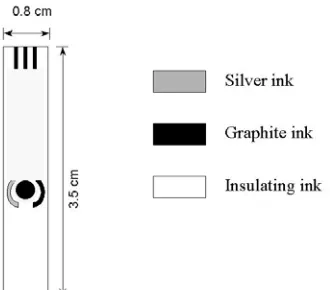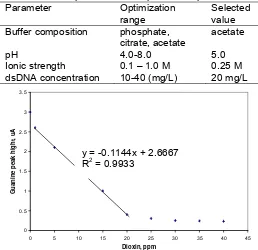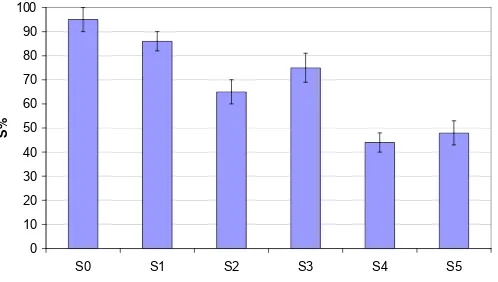AFFINITY BIOSENSOR BASED ON SCREEN-PRINTED ELECTRODE MODIFIED WITH DNA
FOR GENOTOXIC COMPOUNDS DETECTION
Bambang Kuswandi*
Chemo and Biosensors Group, School of Pharmacy, University of Jember Tegal Boto Campus Jl. Kalimantan 37 Jember 68121
Received 15 January 2008; Accepted 21 March 2008
ABSTRACT
An electrochemical method for the detection of the genotoxic compounds using a DNA-modified electrode was developed. This electrode was successfully used for the electrochemical detection of genotoxic compounds in water samples. The electrochemical results clearly demonstrated that, the development is related to the molecular interaction between the surface-linked DNA obtained from calf thymus and the target compounds, such as pollutants, in order to develop a simple device for rapid screening of genotoxic compounds in environmental samples. The detection of such compounds was measured by their effect on the oxidation signal of the guanine peak of the DNA immobilised on the surface of carbon based Screen-Printed Electrode (SPE) in disposable mode, and monitored by square-wave voltametric analysis. The DNA biosensor is able to detect known intercalating and groove-binding genotoxic compounds such as Dioxin, Bisphenol A, PCBs, and Phtalates. Application to real water samples is discussed and reported.
Keywords: electrochemical, screen-printed electrode, DNA biosensor, genotoxic compounds.
INTRODUCTION
Currently, many industrial contaminants reported to have reproducible and endocrine disrupting effects. The specific pollutants would come from many industrial sectors, e.g. the papers and pulp industry, tanneries, refineries and textiles. Such compounds can bind to hormone receptor and mimic or inhibit the action of natural hormones or can affect the synthesis and metabolism, which can also be classified as genotoxic compounds. The compounds are dioxin, bisphenol A, PCBs, pentachlorophenols, phtalates, etc. From this perspective, research in the area of characterising new pollutants in contaminated industrial effluents will be encouraged during the coming year [1].
In order to develop monitoring strategies and methodologies for the characterisation of specific pollutants (i.e. genotoxic compounds), there has been an increase in the use of nucleic acid as a tool in the recognition and monitoring of many compounds of analytical interest. Nucleic acid layers combined with electrochemical transducers produce a new type of affinity biosensor for small weigth molecules. The sensing principle is based on the molecular interaction between the surface linked DNA and target pollutans, which in turn can be used to develop devices for a rapid screening of these compounds.
Electrochemical biosensor offer several advantages like simple immobilisation of the DNA layer (i.e. adsorption driven by a positive electrode potential), faster, low-cost measurements, simplicity, and the use of a miniaturised, disposable and portable instrument as well as hold enourmous potential application in environmental monitoring [2-4]. For instance, a DNA biosensor can be used for the testing of water, food, soil
and plant samples for the presence of interest analytes (pollutants, carcinogens, toxicans, drugs, etc) with binding affinities for the structure of DNA. This binding scheme of small molecules to DNA has been described via the variation of electrochemical signal of guanine [5-7].
Here, the objective of this work was to develop an electrochemical method for the detection of genotoxic compounds as the new and specific pollutants in environmental samples, particularly in aqueous samples. Therefore, affinity biosensor based on the immobilisation of double-stranded DNA on the surface of carbon based Screen-Printed Electrodes (SPE) was developed. Furthermore, the use of the square-wave voltametric method in order to measure guanine oxidation has been employed. In this method, the SPE was used in disposable mode. Since, disposable or single-use sensors have several advantages, such as avoidance of contamination among samples, constant sensitivity and reproducibility and ease of use [8, 9].
The disposable DNA biosensor was used to evaluate the presence of small DNA-binding compounds by measuring changes of electrochemical signal of guanine in calf thymus DNA extract. Some preliminary experiments showing clear electrochemical effect due to the presence of genotoxic compounds, which can be extrapolate and evaluate from potentiallly genotoxic compounds present in real water samples.
EXPERIMENTAL SECTION
Materials
Double stranded calf thymus DNA was purchased from Sigma; sodium acetate, potassium chloride,
Bambang Kuswandi
* Tel/Fax : 0062-331-324736;
Bambang Kuswandi
Fig 1. Schematic of screen printed electrode used for the detection
sodium chloride, acetic acid, ethanol, sodium dihydrogen phosphate were provided from Merck. Dioxin, Bisphenol A, PCBs, and Phtalates were purcahsed from Aldrich. All aqueous solutions were prepared using ultrapure water (Millipore, system). DNA stock solutions (nominally 1000 ppm) were prepared in purified water after taking aliquot and storing in a freezer. All the samples were analyzed using electrochemical DNA biosensor and were tested three times.
Instrumentation
Electrochemical measurements were performed with a PalmSens Electrochemical Portable Apparatus (Palm Instrument BV, Houten, The Netherlands), which is controlled by a Pocket PC. The PalmSens Instrument is used for sensors or cells with two or three electrodes and the dynamic range allows applications as micro as well as macroelectrodes. The Pocket PC software provides easy control of PalmSens.
A disposable biosensor was based on the immobilised double-stranded DNA on the surface of carbon based Screen-Printed Electrode (SPE) donated by Prof. Mascini (Biosensor Lab. Univ. Florence, Italy). The electrochemical cell consisted of a graphite working electrode, a graphite counter electrode and a silver pseudo electrode (Fig. 1). These devices are produced in foiled of twenty electrodes each. Because of the mass-production and the low-cost, these devices can be used as disposables. Each different sample is tested with a new SPE. These planar electrochemical cells can
be used as “drop and sensors” and only 10 μL of sample
solution is required to perform the measurements. The square wave voltammetry conditions were: frequency 100 Hz, pulse amplitude 40 mV and scan increment 15 mV. Potential genotoxic compounds present in water sample can be evaluated by changes of the electrochemical signal of guanine.
Procedure
The procedure consisted of the following steps: (a) calf thymus DNA immobilisation on the electrode
Fig 2. Square wave voltammogram of a SPE
containing 20 mg L-1 dsDNA (a) and 3 μL of a solution
containing 1.0 x 10-5 M (b) and 1.0 x 10-3 M (c) of
dioxin. Supporting electrolyte 0.25 M acetate buffer pH 5.0, Frequency 100 Hz.
surface, (b) dipping the electrode in the sample/blank solution, and (c) electrochemical investigation of the surface.
Calf thymus immobilisation consisted of an electrochemical oxidation (+1.6 V vs. Ag SP pseudo-reference electrode for 2 min in 0.25 M acetate buffer pH 5.0) then the electrode was immersed in a stirred
buffer solution containing 20 mg L−1 of double-stranded
calf thymus DNA. This immobilization step lasted for 2 min holding the electrode surface at a potential of +0.5 V vs. Ag SP reference electrode.
The electrode was then washed with buffer solution for 30 s. The modified electrode was placed in a sample solution for 2 min, and a square wave voltametric scan was carried out to evaluate the oxidation of guanine residues on the electrode surface. The height of the guanine signal (around +1 V vs Ag SPE pseudo-reference electrode) was measured. The square wave voltammetry conditions were: frequency 100 Hz, pulse amplitude 40 mV and scan increment 15 mV.
Potential genotoxic compounds present in water sample can be evaluate by changes of the electrochemical signal of guanine (Fig. 2). We estimate the DNA modification due to the interaction with the analyte as the percentage decrease, which is the ratio of the guanine peak height after the interaction with the analyte and the guanine peak height after the interaction with blank solution as follows:
S% = (G/G0) x 100% (1)
Analysis of water sample
samples were prepared without toxic compounds
spiking. The simulated samples (1000 μl) were then
added with 10 ml of acetate buffer containing 3% (v/v) methanol. The analysis was carried out as described above. For real water sample, a pre-concentration step was necessary to obtain some signals with this technique.
RESULT AND DISCUSSION
Experimental Parameters
Preliminary studies were performed to identify general assay conditions which affected the electrochemical signal of the guanine oxidation peak, like ionic strength, pH, buffer composition and double-stranded DNA concentration. Table 1 reports the optimization results of experimental parameters. The modified electrode performance was tested in a buffer solution containing methanol up to 10% (v/v) and we did not observe any variation of the electrochemical signal of guanine peak. Methanol is useful for dissolving some organic compounds.
The guanine peak was sharp in acetate buffer; the baseline at this value was lower than other buffer. The guanine peak height obtained as function of pH, shows that the signal height increases linearly with pH value up to 5.0 and then tends to be constant. While for ionic strength (in this case acetate buffer was used) 0.25 M
Table 1. The optimisation of experimental parameters. Parameter Optimization
range
Selected value
Buffer composition phosphate,
citrate, acetate
acetate
pH 4.0-8.0 5.0
Ionic strength 0.1 – 1.0 M 0.25 M
dsDNA concentration 10-40 (mg/L) 20 mg/L
0
Fig 3. Biosensor response toward dioxin. The linear decrease of the guanine peak height with the dioxin concentration in the range 1–20 mg/L.
shows to be an optimum value. The guanine peak height was obtained as function of double-stranded calf thymus concentration. The peak height increases
linearly with concentration up to 20 mg L−1 and then
levels off. These values were used for further measurements.
Response toward Genotoxic Compounds
Using modified SPE with dsDNA and analyzing
dioxin (2,3,7,8-tetrachlorodibenzo-p-dioxin), PCB105
and bisphenol A, a decrease in the guanine peak height was obtained in low concentration of analytes. We attribute such results to the intercalation of the compounds between the base pairs in the double-stranded DNA inducing an easy oxidation of guanine. The linear decrease of the guanine peak height with
the dioxin concentration in the range 1–20 ppm
(mg L−1) has been found (Fig. 3). The signals were
observed within the range 0–1.2 ppm for PCB105 (Fig. 4) and 1-120 ppm for bisphenol A respectively (Fig. 5).
0
Fig 4. Biosensor response toward PCB 105. The linear decrease of the guanine peak height with the PCB 105 concentration in the range 0–1.2 mg/l.
Figure 5. Biosensor response toward Bisphenol A. The linear decrease of the guanine peak height with the Bisphenol A concentration in the range 1–120 ppm.
0 Table 2. Results of the water samples obtained using
dsDNA immobilised on SPE.
Sample Compound added
(mg/mL)
Bisphenol A (50)
37 ± 2
M2 Phthalates (25) +
Aroclor 1260 (25)
87 ± 2
E1 Tap water 100
E2 River water 85 ± 3
*Each measurement repeated 3 times.
However, when the mixture of genotoxic compounds tested, e.g. mixture of phthalates and the PCB (Aroclor 1260) were analyzed by modified SPE with dsDNA, a slightly decrease in the peak height was observed. The more difficult oxidation of the guanine can be due to the bond of DNA with phthalate or Aroclor. The signal of the biosensor was observed within the range 0–50 ppm for this mixture. However, the sensor is not able to distinguish between compounds of the environmental concern but could be conveniently used as a screening tool of toxicity (genotoxicity) of water samples. This is due to simplicity and short time involved in the measurement procedure, which would be suitable for field measurements. Therefore, this work opens the possibility of rapid evaluation as water samples toxicity.
Applications
Applicability to the analysis of water samples is also illustrated in Table 2. A decrease of the guanine peak height could be detected with some water samples that have been spiked with toxic compounds as well as in river water sample. By using signal response of the biosensor as given in eq. 1 to measure toxicity of water sample tested, we can make toxicity criteria as follows:
S > 85% = non toxic;
50% < S < 85% = moderately toxic;
S < 50% = toxic (2)
Fig. 6 shows the results of the water samples collected from various sources, which were mainly urban wastes (S0=buffer as reference; S1 = domestic waste; S2 = agricultural waste; S3 = Office waste; S4 = industrial waste; and S5 = lab waste). The sample (S1) from domestic waste can be classified as non-toxic sample. Samples S2 and S3 (agricultural and office wastes) can be categorized as moderately toxic sample, while samples S4 and S5 can be categorized as toxic sample. Generally, the DNA biosensor was able to discriminate between the toxic and non-toxic samples,
Fig 6. DNA biosensor results for various water samples; S0=buffer as reference; S1 = domestic waste; S2 = agricultural waste; S3 = Office waste; S4 =industrial waste; and S5 = lab waste.
indicated a low and high presence of molecules with binding affinity for the DNA.
CONCLUSION
In the present work, electrochemical DNA biosensors are proposed as a screening device for the rapid bio-analysis of genotoxic compound or toxicity of samples. The results show that the DNA biosensor could be a very good test, since it can give rapid and easy information to evaluate the presence of genotoxic compounds with the affinity for nucleic acids. The genosensors may represent an easy and rapid way of analysis of toxic or polluted area, particularly for field applications, being one of the most competitive tools in term of time and cost of analysis. Furthermore, such biosensor could be useful as early warning device for environmental monitoring. Electrochemical DNA biosensors offer other several advantages like an easy immobilization of the DNA layer, fast measurement, portable instrumentation suitable for measurements in situ, in field screening analysis of toxic compounds and cost effective, moreover the disposable single use biosensor avoids contamination among samples and allows constant sensitivity and reproducibility.
ACKNOWLEDGEMENT
This research was supported by the International Foundation for Science (IFS), Stockholm, Sweden, and the Organisation for the Prohibition of Chemical Weapons, The Hague, The Netherlands, through a grant to B.K. The authors also thank to Prof. M. Mascini (Univ. Florence, Italy) for the donation of SPE and valuable discussion on DNA biosensors.
REFFERENCES
1. Kuswandi, B., Tombelli, S., Marazza G., and
Mascini, M., 2005, Chimia Journal, 59, 242.
2. Wang, J., Cai, X., Rivas, G., Shirashi, H., and
Dontha, N., 1997, Biosens. Bioelectron, 12, 7, 587.
3. Marazza, G., Chianella, I., and Mascini, M., 1999, Anal. Chim. Acta, 387, 297
4. Mascini, M., 2001, Pure Appl. Chem., 73, 23.
5. Wang, J., Rivas, G., Luo, D., Cai, X., Valera, F.S.,
and Dontha, N., 1996, Anal. Chem., 68, 4365.
6. Jelen, F., Fojta, M., and Palecek, E., 1997, J.
Electroanal. Chem., 427, 49.
7. Marazza, G., Chianella, I., and Mascini, M., 2001, Anal. Chim. Acta, 427, 155.
8. Del Carlo, M., Lionti, I., Taccini, M., Cagnini, A.,
and Mascini, M., 1997,Anal. Chim. Acta, 342, 189.
9. Palchetti, I., Cagnini, A., Mascini, M., and Turner,
A.P.F., 1999, Mikrochim. Acta, 131, 65.


